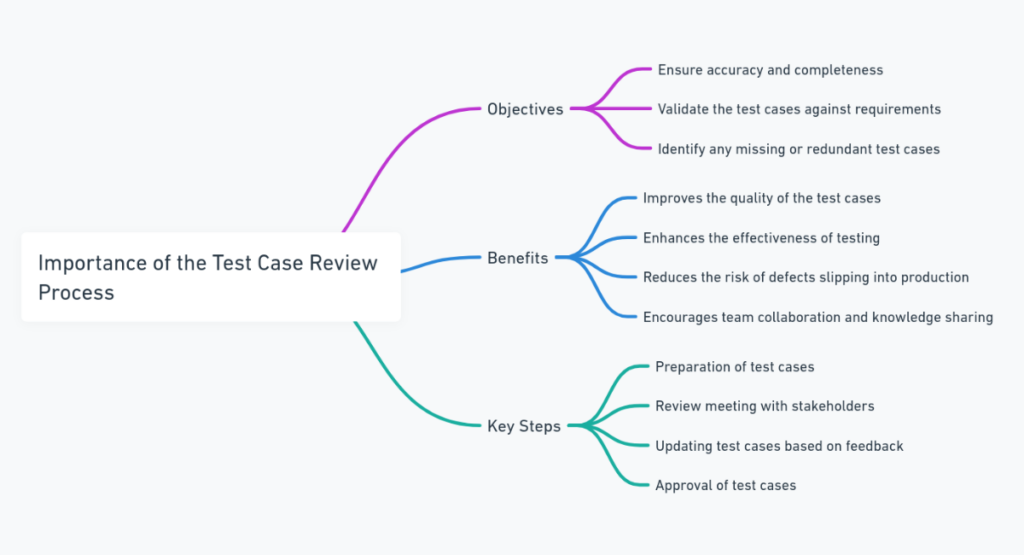In the world of software development, The quality of the product that is developed is crucial. One crucial process to ensure this is the review of test cases. This involves a thorough analysis of the test scenarios that are used to test the capabilities and performance of the software.
Through involving multiple stakeholders including testers, developers, and occasionally even customers, a test case review aims to uncover any errors, gaps, or other issues that need to be addressed to ensure that the testing is complete.
This kind of collaboration will not only improve the efficiency and accuracy of testing but is also a significant factor in the quality of the final product.
Engaging in a rigorous review of test cases is a good practice in quality assurance that will reduce time and costs by avoiding costly errors later on the road.
It's an essential part of making sure that software can surpass those expectations set by its customers.
Importance in the Test Case Review Process

The process of reviewing test cases is a crucial part of the testing process of software and ensures the release of reliable and high-quality software products.
This process, which is integral to quality assurance processes includes a variety of benefits that are crucial to the development of software and maintenance.
Assuring the highest quality and reliability.
The principal reason to conduct test case reviews is to check the reliability and quality of the software that is being created. By carefully reviewing every test, teams can confirm that every test is in line with the needs of the business and users' expectations.
This comprehensive review aids in identifying any gaps or misinterpretations in the specifications, as well as ensuring that the software is performing in a manner that is appropriate for the various situations.
Therefore, this does not just improve the product's quality but also improves customer satisfaction, while also fostering trust and confidence within the software.
Identifying and catching defects early
A thorough review of test case procedures helps to identify flaws earlier in the development process. Recognizing and fixing issues in the early stages of development can stop their growth into more serious issues, which can cost more and take longer to address later.
Being able to identify defects early will not only cut down on the total cost of testing and maintenance but also speed up your development cycle, which allows faster time-to-market.
Furthermore, by making sure that every test is designed to reveal weaknesses The review process dramatically minimizes the possibility of severe defects making it into manufacturing environments.
The Best Practices for Test Case Review
Implementing the most effective practices during the process of reviewing test cases will significantly increase its efficiency and efficiency.
These methods ensure an easier and more cooperative approach to testing software which reduces the chance of making mistakes, while also encouraging creativity and continual improvement.
Collaboration Among Team Members
Collaboration between team members is essential for the review process. Facilitating the creation of an inclusive and open atmosphere in which developers, testers, and other users can freely share their thoughts and suggestions provides a more comprehensive overview.
This type of collaboration is not only a way to leverage the different skills of the team but also fosters a deeper understanding of the software's functions and potential problems.
The environment is conducive to the continuous learning process and improvement, making the reviewing process more efficient and effective.
Automation Tools Leveraging
Automating the review of test cases can greatly improve its effectiveness and efficiency. Automated tools aid in identifying duplicate or missing test cases, while ensuring that they adhere to the standards, or even checking the quality of the requirements.
By automating tedious and time-consuming tasks teams can spend more time studying to improve the efficiency of tests.
Furthermore, these tools can provide useful insights and statistics that help in continuous improvement, which makes the process of reviewing more thorough and efficient.
Incorporating Industry Standards
Implementing best practices and industry standards into the review of test cases procedure ensures consistency, trustworthiness, and high-quality software testing.
Respecting recognized standards, like IEEE 829 for test documentation and ISO/IEC/IEEE 29119 for test software, offers the same methodological framework for preparing and reviewing test cases.
This not only increases the credibility of the testing process but also allows for more effective communication and understanding among the team members and other stakeholders.
By aligning the review of test cases to industry standards, companies can achieve greater effectiveness and efficiency when it comes to their test software procedures which ultimately leads to better product quality.
Methods to Conduct a Successful Test Case Review
To ensure the accuracy and effectiveness of testing software, conducting an effective review of test cases is crucial. This requires a variety of stages, starting with the preparation of test cases, to the tracking of feedback and effectively implementing it.
Preparing Test Cases to Review
Before the review Before the review meeting, it is important to plan the test cases thoroughly. This includes making sure that every test case is documented well clearly and precisely, as well as adhering to the testing guidelines of the project.
Here are some guidelines to help you prepare tests for review:
Make sure that the test case is clear and comprehensive:
Every test case must be written, describing the steps required to complete the test, the anticipated outcome, and the final results. This helps examiners comprehend the intent and purpose of test scenarios.
Follow the Standards:
Established standards for the writing of test instances. This includes utilizing an identical structure as well as language and levels of detail. This helps with review and understanding.
Examine Test Data:
Ensure that all the test data you need is identified and included. This is vital in the performance of the tests.
Verify Relevance:
Make sure that every test case is pertinent to the requirements of the present and the functionality of the software that is being tested. Test cases that are not relevant or outdated must be changed or deleted.
The Conducting of the Review Meeting
The review of test cases is a joint effort that involves the testing team, and sometimes others from different departments. The purpose is to analyze the test cases and identify the areas that require improvement.
For a productive review session, you should consider the following points:
Set clear goals
Start with an understanding of the goals the review is aiming to accomplish. This could include increasing the accuracy of tests, making sure that they cover the full range of all functions as well as identifying duplicate tests.
Encourage Open Communication
Facilitate an open and honest dialogue as well as constructive feedback. Each participant must feel comfortable sharing ideas and ideas without fear of being judged.
Structured Approach
Utilize a Structured Approach to go through the test cases step-by-step perhaps arranging them according to function or module. This helps make the process more efficient and organized.
Document Feedback
Delegate an individual with the responsibility of recording the decisions and feedback taken during the meeting for future review.
Monitoring and implementing feedback
After the review, It is crucial to monitor and effectively implement the feedback. This includes:
Prioritizing feedback.
Not every feedback will receive the same priority. Certain changes could be crucial and require immediate attention while others could be a possibility as possible changes.
Assignment of tasks:
Based on feedback that you receive, assign tasks to the appropriate team members to revise tests. Make sure there is clarity about what's required and when.
Follow-up:
Create an ongoing process to monitor the status of revisions and to ensure that all feedback is properly addressed.
The Challenges in the Test Case Review Process
While the review of the test cases process is vital to ensure the highest quality test cases, the process also comes with its own set of difficulties.
Time Constraints
One of the biggest issues during the review procedure is managing the time efficiently. Meetings for review can become very time-consuming and teams are often unable to manage them alongside other tasks related to testing.
To reduce this review time, it's essential to:
- Plan Reviews: Ideally Review meetings should be scheduled at times in the development cycle when they'll prove most useful and most peaceful.
- Be Prepared: Making sure your test scenarios are properly prepared and review meetings are organized will significantly cut down on the time needed.
Resistance to Change
Another issue is resistance to change by members of the test team, or from other stakeholders. Some people may be reluctant to modify test cases they've created or change their methods.
For this reason, there are steps to take:
- Promote a culture that is Continuously Improved: Focus on the advantages of the review process, for example, higher tests' quality and effectiveness.
- Include everyone in the Review Process: Engaging all participants during the review process to increase their acceptance and lessen resistance to the suggestions for changes.
In conclusion, although there are some challenges to the review of test cases with careful planning and communication that is open, as well as the focus on continuous improvement, they can be successfully handled.
Following the steps described above teams can carry out efficient reviews of test cases, which will result in better quality software testing results.
Tools for Streamlining Test Case Review
The quality of the software is not just extensive testing but also a thorough review of test cases. To make this part that is quality-assurance, using the right tools is vital.
Here, we look at two essential classes of tools that will greatly improve the effectiveness and efficiency of your review processes.
Test Management Software

Test Management Software acts as the foundation to manage and organize the testing process for software. These software tools offer a central platform that allows test cases to be designed as well as reviewed, archived, and monitored.
They aid in collaboration between teams by allowing the easy assignment of review tasks as well as the recording of any modifications or feedback.
The majority of these software applications include features like:
- Templates to create standardized test cases
- Version control is used to monitor any changes that are made in the process of reviewing
- Integration with tools for bug tracking to make sure that all issues identified are addressed
- Reporting capabilities that allow you to track the effectiveness and progress of the test process
Platforms such as ContextQA, TestRail, Zephyr, and QTest are good examples, each offering an extensive set of functions designed to meet the needs of different testing environments and needs.
Code Review Tools
Although they are primarily designed to review codes, tools for code review are also able to play a major part in the review process, particularly in tests that are tightly connected to the code, for example, unit tests.
These tools aid peer reviews by highlighting any changes or suggestions for improvement, as well as stimulating discussion between both testers and developers.
The features include:
- Inline comments to provide feedback on particular parts of the test or code
- Automated rules to ensure that certain standards for review are met before merging
- Integration with continuous integration/continuous deployment (CI/CD) pipelines to automatically run test cases upon code submission
Tools such as Gerrit, Review Board, and GitHub's built-in review capabilities demonstrate how software for reviewing code can help improve not only code quality but also the reliability of tests.
In the end, the test management and code review tools are valuable tools to enhance the review of test cases. When you choose to integrate these tools in the software testing process to guarantee a higher degree of quality assurance and effectiveness.
Book a Demo and experience ContextQA testing tool in action with a complimentary, no-obligation session tailored to your business needs.
Conclusion
In the end, the review of test cases procedure is an essential element of quality assurance when developing software. It makes sure that every scenario is considered, and any potential problems are addressed before they become problematic.
The systematic review does not just improve your overall product's quality, it improves collaboration among teams and understanding.
By adhering to the most effective methods, which include communicated information, well-written documentation, and following well-organized review procedures, teams will greatly improve their performance when it comes to software testing.
Implementing an extensive review of the test cases process may be daunting initially however its benefits to team quality and efficiency are undisputed.
It helps not only to identify mistakes early on during the development process but also allows teams to develop more robust, reliable, and user-friendly software.
The goal isn't just to spot faults, but to analyze the application at a more profound and ensure that the functions function exactly as they should in real-world scenarios.
To summarize, take note of the following important lessons to be learned from an effective review procedure:
- Prioritize clear and transparent communication between all team members
- Maintain a complete record to be used for reference in the future and also to ensure accountability
- Follow a well-organized review flow to ensure maximum effectiveness and coverage
- Utilize the expertise and expertise of the whole team for a thorough review
When you incorporate these best practices in your test case review procedure, you will significantly increase the reliability and quality of your software which will ultimately result in more satisfied customers and users.
You may also Interested in Top 5 Software Testing Trends of 2024
We make it easy to get started with the ContextQA tool: Start Free Trial.
